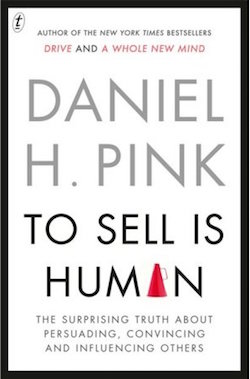Seven Pitch Techniques to help you be more persuasive
Having a range of pitch techniques in your toolkit is vital if you want to be effective at persuasion and influence. And this is not just for sales. You can use pitch techniques in a meeting to present an idea, a presentation to position a message or in a blog or video to influence your audience and promote action.
I love Dan Pink’s work. I’ve read all five of his books and rapped two of them over at Book Rapper. And, today we draw from his most recent book: To Sell is Human.
A pitch is a persuasive message. As Pink suggests, a pitch is not about completing a sale. Instead, its purpose is to start a conversation, to inspire interest and have your audience ask ‘Tell me more…’ Here are seven pitch techniques from Pink’s book.
 1 The Elevator Pitch
1 The Elevator Pitch
If you found yourself in a lift with your boss or a possible client could you tell them what you do in the limited time you zoom from one building level to another? Mostly, we’ve all had enough of elevator pitches. They’re usually over-rehearsed cliché driven, formula riddled statements that cause more eyes to roll than brain cells to whirr.
2 The One Word Pitch
Yep, you read it right – one. For instance, Google = Search and Mastercard = Priceless. This idea comes from adland and Maurice Saatchi who co-founded Saatchi and Saatchi with his brother Charles. A one-word pitch aims to be a single idea in the mind of your audience. Whilst you might think this is simplistic, being able to distil your idea in this way will take a lot of thinking, conversation and refinement.
3 The Question Pitch
The problem with statements is that we respond passively to them. In contrast, how do we react when a question is posed? The answer… we are automatically engaged to answer it. And, by stimulating a response the person answering will feel more strongly about it and is, therefore, more likely to act upon it. For example, for Book Rapper we could ask: Are you reading all the business books that you would like to?
4 The Rhyming Pitch
In the OJ Simpson murder trial, his lawyer Johnnie L Cochran produced a match-winning move when in his summing up he said the following rhyming pitch: If it (the glove) doesn’t fit, then you must acquit. Linguists and cognitive scientists call this ‘processing fluency’. This means the simpler a message is portrayed the more likely we are to believe it to be true. And, it follows that rhymes are a special seasoning because they add to our reasoning.
5 The Subject-Line Pitch
What makes you open one email and not another? One big factor is who is sending it to you. Another is the subject line. Researchers who studied which types of email subject lines were most effective came up with three principles:
- Utility – We’re most likely to open an email that will ‘directly affect our work’. This is particularly effective for people who receive a lot of emails. For instance: ‘The three best business books on Innovation’
- Curiosity – We’re most likely to open an email that has ‘moderate levels of uncertainty about the contents’. In other words, they spark our curiosity. Curiosity worked better when there were fewer emails. For instance, ‘Innovations Lessons from Coffee’.
- Specificity – ‘Seven Pitch Techniques’ is more likely to be opened than ‘Some Pitch Techniques’.
6 The Twitter Pitch
A tweet is limited to 140 characters. Can you pitch your idea in that limited space? Researchers have found the most engaging tweets are those that:
- Ask Questions (see Pitch #3)
- Provided useful information as well as a link to more info
7 The Pixar Pitch
Pixar is one of the most successful film studios in the world. They’re the creators behind favourites such as Toy Story, Finding Nemo and The Incredibles. They’ve won 26 Oscars. One of the starting points for their success is a six-part storytelling template they use to pitch their movie ideas. It looks like this:
Once upon a time _______. Every day, _______. One day, _______. Because of that, _______. Because of that, _______. Until finally, _______.
Here’s one example I put together for Book Rapper: Once upon a time, it was easy to keep up with your business book reading. Every day, you had a little time where you could squeeze in a quick read. One day, you realized you were too busy to read. Because of that, you skipped the next day too. Because of that, your habit for reading a little every day died. Until finally, you found you were no longer keeping up with all the changes in your industry.
ACTION: Create at least one example of each pitch technique to sharpen your levels of persuasion.


 1 The Elevator Pitch
1 The Elevator Pitch

